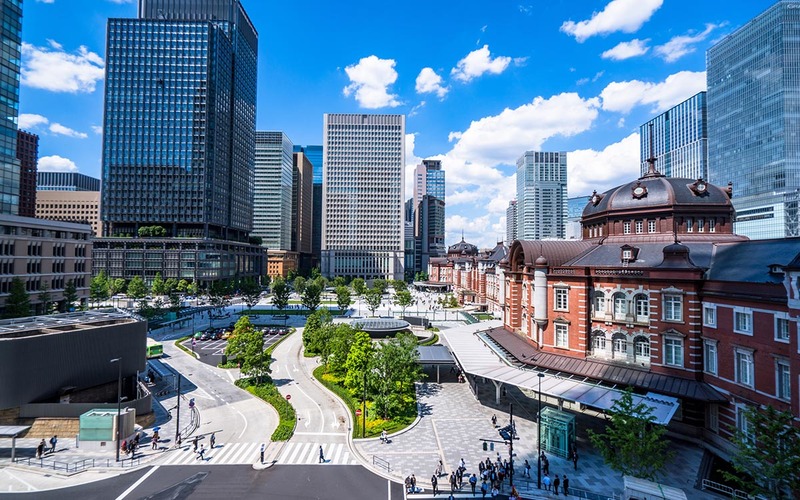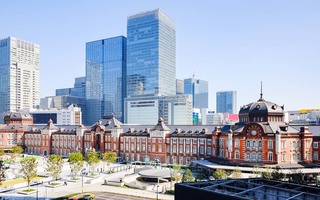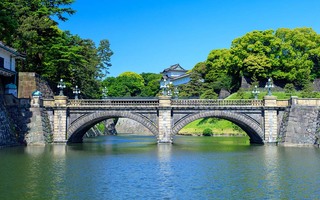All Eyes on the Gateway to the Capital City of Tokyo
Audio Guide of the Marunouchi and Imperial Palace Area

Marunouchi · Exploring the Imperial Palace Area
Tokyo is the face of Japan. Tokyo station is a gateway into this capital city. Behind the station lies the areas of Marunouchi and the Imperial Palace, which were built between the Edo and Meiji eras at astonishing speed.
In the aftermath of World War II, the city made a miraculous recovery in front of a global audience. Even with its turbulent history, the metropolis continues to evolve on its own terms, developing advanced technology while maintaining its distinctive traditional culture.
Tokyo station, where all the bullet trains meet, is currently the third most visited station in Japan after Shinjuku and Ikebukuro. The splendor of the area called "Office City Marunouchi" which surrounds the station has also long been a place to unwind for local business men and women alike.
Notably, the museums in the area have escaped being burned down in the war and are preserved as symbols of the new era. The Kokyo Gaien National Garden especially, is a place that few tourists pass up.
Come with us on a tour of the Marunouchi and the Imperial Palace area, where modern Tokyo and old Edo co-exist.

A Tokyo Station

B Kokyo Gaien National Garden
A
Tokyo Station

Tokyo Station, a major train base, first opened in 1914. The first railway in Japan, however, had actually been built 42 years before, running between Shinbashi and Yokohama. The reason for this belated development was the financial difficulties the government faced, allowing private railway companies to enter the railway market. Consequently, there were no plans to connect such private company railways as a transportation network for the city.
However, in order to extend the route to the Tohoku area as part of urban planning efforts in Tokyo, the openings of Shinbashi and Ueno Stations became urgent. As a result, construction of Tokyo Station was finally able to commence.
For the design of the station building, well-known architect Kingo Tatsuno was hired by the city. He is considered to represent that era’s aesthetics as he had a hand in designing a number of large Western-style buildings that blend well into the Japanese landscape.
Later, the third floor of the station building would be destroyed by air raids during World War II, but it was quickly repaired and converted into a two-story building.
Today, all the Shinkansen, or bullet trains, meet in Tokyo Station, as it is the terminal connecting every corner of the mainland. In 2013, the main building underwent a massive restoration to its former red-brick glory.
During Tokyo Michiterasu, a year-end festive event, the majestic and beautifully lit-up Tokyo Station is the talk of the town. In addition, part of the station building also houses traditional and boutique hotels, offering a luxurious escape from the hustle and bustle of the city.
B
Kokyo Gaien National Garden

The Imperial Palace is bookended by two parks: Kitanomaru Park on the north end and Kokyo Gaien National Garden on the south side. Kokyo Gaien National Garden is open to the public as a park adjacent to the Imperial Palace.
When it comes to sightseeing in Tokyo, many people cite the Imperial Palace as the first on their list. Considered as a starting point for Tokyo tourism, the garden is crowded with many tourists from across Japan and all over the world throughout the year.
In particular, in front of the Imperial Palace on the Marunouchi side, grass was planted with black pine scattered between gravel roads for an even more spacious effect.
In front of Kokyo Gaien National Garden is the Nijubashi Bridge. Further on, are the famous Sakurada-mon Gate and Sakashita-mon Gate synonymous with the Bakumatsu end to the Edo period. It is also a famous filming location.
This area is extremely popular as a jogging course, as runners can be seen here at any time of day. Despite the park's picture-perfect setting, during World War II it was from this location that the Imperial Government broadcast news of the country's surrender and where the Bloody Mayday incident, a catastrophe that ended with many lives lost, occurred. Archive footage of both historic events can still be found today.